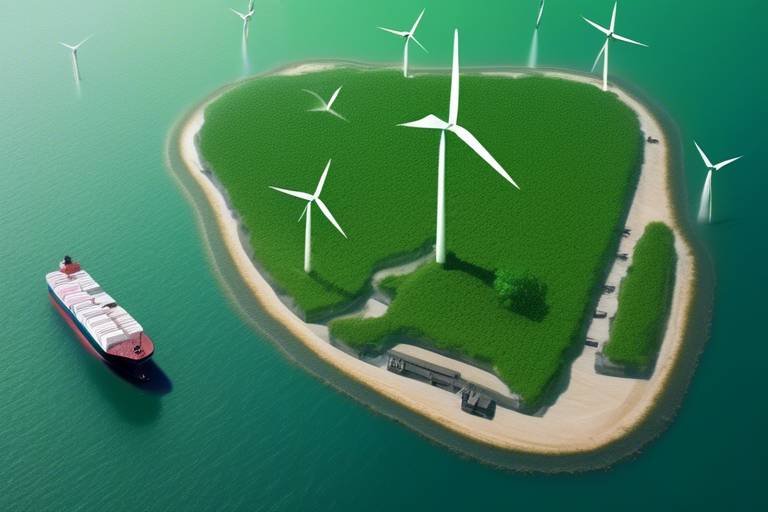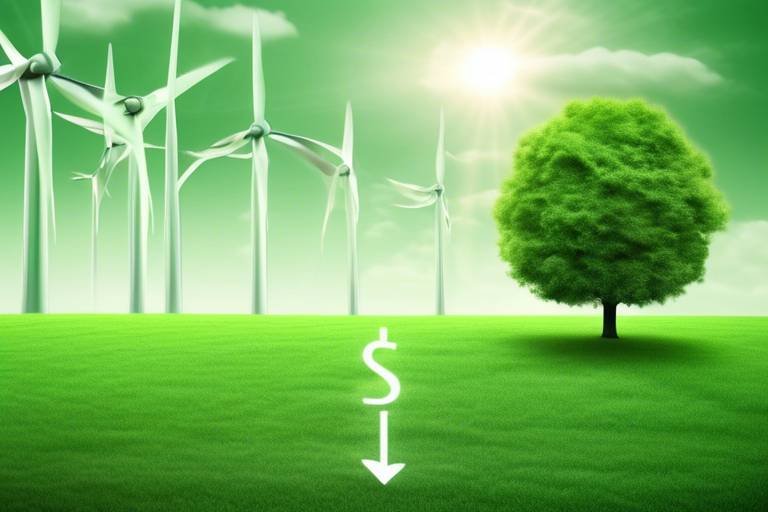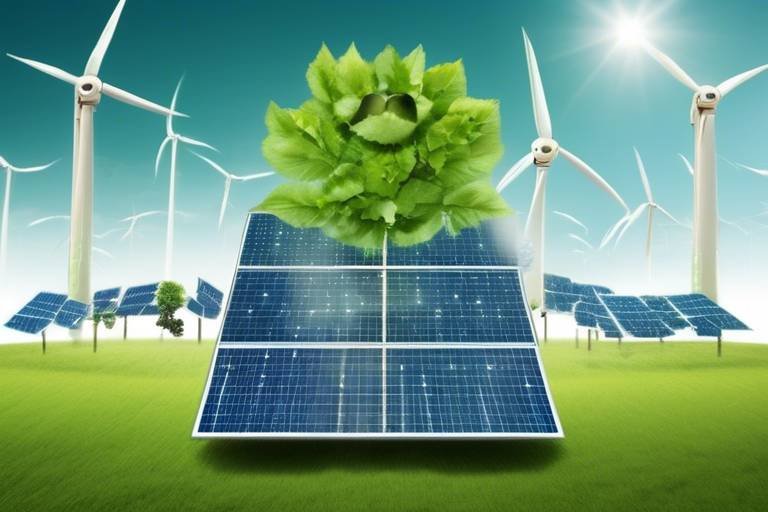Effectively Communicating the Benefits of Green Energy
In today's world, the conversation around energy has shifted dramatically, and it's crucial to effectively communicate the benefits of green energy. With climate change knocking at our doors and natural resources dwindling, the need for a sustainable energy transition has never been more urgent. But how do we articulate these benefits to diverse audiences? It's about more than just facts and figures; it's about connecting with people on a personal level. By understanding the core advantages of green energy—its environmental, economic, and social impacts—we can tailor our messaging to resonate with various stakeholders, from policymakers to everyday consumers. Let’s dive into the details and explore how to make green energy not just a necessity, but a compelling choice for everyone.
So, what exactly is green energy? In simple terms, it refers to energy derived from natural sources that are replenished more quickly than they are consumed. This includes sources like solar, wind, hydro, and geothermal energy. Unlike traditional energy sources such as coal and oil, which can deplete and cause significant environmental harm, green energy is sustainable and much cleaner. Understanding this distinction is vital as we move forward in discussing the myriad benefits of switching to renewable energy. It’s like choosing between a fast food meal that leaves you feeling sluggish and a fresh salad that revitalizes you; one option nourishes your body while the other may lead to longer-term health issues.
The environmental benefits of green energy are profound and far-reaching. By transitioning to renewable energy sources, we can significantly reduce greenhouse gas emissions, which are the primary culprits behind climate change. This shift not only helps in conserving natural resources but also promotes biodiversity. Imagine a world where air quality improves, wildlife thrives, and our natural landscapes remain untouched. The urgency of this transition cannot be overstated; every small step we take today can lead to monumental changes for future generations.
One of the most compelling arguments for green energy is its ability to lower both individual and collective carbon footprints. Did you know that switching to renewable energy can reduce your carbon emissions by up to 80%? This statistic is not just a number; it's a powerful reminder of our potential impact. Real-world examples abound, showcasing communities that have embraced solar and wind energy, resulting in marked reductions in their carbon footprints. It's akin to the difference between driving a gas-guzzler and opting for a fuel-efficient vehicle; the choice you make today has lasting implications for the planet.
Solar energy systems have made significant strides in recent years, contributing to a notable decrease in carbon emissions. Take, for instance, the city of San Diego, which has implemented extensive solar initiatives. Their efforts have not only reduced emissions but have also provided long-term environmental benefits, showcasing the potential for solar energy to be a game-changer in our fight against climate change.
Wind energy also plays a pivotal role in minimizing environmental damage. Wind farms are popping up worldwide, harnessing the power of nature to generate clean energy. These farms have proven to be efficient and sustainable, demonstrating that we can meet our energy needs without sacrificing the health of our planet. Think of wind energy as the refreshing breeze on a hot summer day—invigorating and essential for our well-being.
Beyond the environmental benefits, green energy offers substantial economic advantages. We're talking about job creation, increased energy independence, and long-term savings for consumers and businesses alike. Investing in renewable technologies is not just an ethical choice; it's a smart financial decision. For example, the solar industry alone has created hundreds of thousands of jobs in the last decade, proving that sustainability can fuel economic growth.
Transitioning to sustainable energy sources also carries significant social implications. It fosters community engagement, improves public health, and enhances overall quality of life. By investing in green energy, we are not only protecting the environment but also creating healthier, more resilient communities.
Green energy initiatives empower local communities to take charge of their energy needs. Grassroots movements and collaborative projects are springing up, promoting sustainability and resilience. It’s like planting seeds in a garden; with the right care and attention, these initiatives can flourish and yield bountiful results.
Lastly, let’s not overlook the public health benefits that come from using green energy. Reduced pollution levels lead to fewer health issues, which ultimately benefits society as a whole. Cleaner air means fewer respiratory problems, and that’s something everyone can get behind. Transitioning to renewable energy is not just an environmental issue; it’s a public health imperative.
1. What is green energy?
Green energy is energy derived from renewable resources that are naturally replenished, such as solar, wind, and hydro power.
2. How does green energy benefit the environment?
It reduces greenhouse gas emissions, conserves natural resources, and promotes biodiversity.
3. Can switching to green energy save money?
Yes, investing in renewable energy can lead to long-term savings for both consumers and businesses.
4. How does green energy impact public health?
By reducing pollution, green energy contributes to fewer health issues and improved overall public health.

Understanding Green Energy
Green energy is a term that refers to energy derived from natural sources that are replenished at a faster rate than they are consumed. Unlike traditional energy sources, such as coal, oil, and natural gas, which can deplete over time and contribute to environmental degradation, green energy is sustainable and has a minimal impact on the planet. This includes sources such as solar, wind, hydroelectric, and geothermal energy. The transition to green energy is not just a trend; it's a necessity for our planet's health and our future.
When we talk about green energy, we’re essentially discussing a variety of renewable energy sources that harness the power of nature. Here’s a quick breakdown of the most common types:
- Solar Energy: Harnessed from the sun, solar energy can be converted into electricity or heat.
- Wind Energy: Generated by wind turbines, wind energy captures the kinetic energy of wind and transforms it into electrical power.
- Hydroelectric Energy: This form of energy utilizes flowing water to generate electricity, typically through dams.
- Geothermal Energy: Derived from the Earth’s internal heat, geothermal energy can be used for heating and electricity generation.
What sets green energy apart is its ability to provide a sustainable solution to our energy needs without the adverse environmental impacts associated with fossil fuels. For instance, while fossil fuels release harmful greenhouse gases that contribute to climate change, green energy sources produce little to no emissions. This essential distinction highlights why the shift towards renewable energy is crucial in combating global warming.
Moreover, the importance of green energy in today's world cannot be overstated. As we grapple with the effects of climate change, rising energy costs, and the depletion of natural resources, the conversation around renewable energy becomes increasingly urgent. By embracing green energy, we not only work towards a cleaner environment but also pave the way for economic growth and social equity. The benefits are multifaceted, making it a pivotal topic in discussions about our planet's future.
In summary, understanding green energy is about recognizing its potential to transform our energy landscape. It stands as a beacon of hope, promising a future where energy is not only abundant but also sustainable. As we delve deeper into the benefits of green energy in the following sections, it becomes clear that this is not just an environmental issue; it's a comprehensive approach to building a better world for ourselves and future generations.

Environmental Benefits
When we talk about green energy, we're not just discussing a trend; we're diving into a transformative movement that has profound implications for our planet. The environmental benefits of transitioning to renewable energy sources are nothing short of revolutionary. Imagine a world where the air is cleaner, the water is purer, and the natural habitats are thriving again. This is not just a fantasy—it's a future we can create through the adoption of green energy. By harnessing the power of the sun, wind, and other renewable sources, we can significantly reduce our reliance on fossil fuels, which are notorious for their harmful emissions.
One of the most pressing issues we face today is climate change, and green energy plays a crucial role in addressing this challenge. By shifting to renewable energy, we can drastically lower greenhouse gas emissions. For instance, studies show that switching to solar and wind power can cut emissions by up to 80% in some regions. This is a staggering statistic that highlights the urgency of making the switch. Not only does this transition help combat climate change, but it also conserves our precious natural resources. Fossil fuels are finite, and their extraction often leads to devastating environmental degradation, including oil spills, habitat destruction, and water contamination.
Additionally, green energy promotes biodiversity. When we invest in sustainable energy sources, we are not just protecting ourselves; we are also safeguarding the ecosystems that countless species depend on. For example, wind farms, when properly sited, can coexist with wildlife, providing clean energy without significant harm to the environment. This balance is critical, as healthy ecosystems contribute to the overall resilience of our planet.
To put it into perspective, consider the following table that outlines the environmental impacts of different energy sources:
| Energy Source | Greenhouse Gas Emissions | Resource Conservation | Biodiversity Impact |
|---|---|---|---|
| Coal | High | Depletes natural resources | Negative |
| Natural Gas | Moderate | Depletes natural resources | Negative |
| Solar | Very Low | Renewable | Positive |
| Wind | Very Low | Renewable | Positive |
This table clearly illustrates the stark contrast between traditional energy sources and their greener counterparts. By investing in green energy, we are not only making a choice for ourselves but also for future generations. The urgency to transition to sustainable energy has never been clearer. As we face rising global temperatures and increasingly erratic weather patterns, the need for action is pressing. It's not just about saving the planet; it's about ensuring a livable future for all.
In summary, the environmental benefits of green energy are vast and multifaceted. From reducing carbon footprints to conserving resources and promoting biodiversity, the advantages are compelling. As we continue to explore the potential of renewable energy, it becomes increasingly evident that embracing these technologies is essential for a sustainable future.
- What is green energy? Green energy refers to energy derived from natural sources that are replenished over short periods, such as solar, wind, and hydroelectric power.
- How does green energy reduce greenhouse gas emissions? By replacing fossil fuels with renewable sources, green energy significantly lowers the amount of carbon dioxide and other harmful gases released into the atmosphere.
- What are the economic benefits of green energy? Green energy can lead to job creation, energy independence, and long-term savings for consumers and businesses.

Reducing Carbon Footprint
When we talk about reducing our carbon footprint, we’re diving into a crucial aspect of green energy that directly addresses the pressing issue of climate change. The carbon footprint refers to the total greenhouse gas emissions, particularly carbon dioxide, that are directly or indirectly associated with our activities. By shifting to renewable energy sources, we can significantly lower these emissions, making a tangible difference in the fight against global warming. Imagine if every household switched to solar or wind energy; the collective impact would be akin to taking millions of cars off the road!
Statistics show that energy production is one of the largest contributors to carbon emissions. In fact, according to the Environmental Protection Agency (EPA), approximately 65% of greenhouse gas emissions in the United States come from electricity generation. This staggering figure highlights the urgent need for a transition to green energy. For instance, a family that opts for solar panels can reduce their carbon footprint by an impressive 3 to 4 tons of carbon dioxide per year. That’s the equivalent of driving from New York City to Los Angeles and back!
Furthermore, the transition to green energy isn’t just about individual choices; it’s a movement that encourages communities and businesses to adopt sustainable practices. Take, for example, the rise of community solar projects. These initiatives allow multiple households to share the benefits of a single solar array, making renewable energy more accessible and affordable. As a result, entire neighborhoods can reduce their carbon footprints collectively, fostering a sense of community and shared responsibility.
Real-world examples further illustrate the effectiveness of renewable energy in combating climate change. In Denmark, wind energy accounted for about 47% of the total electricity consumption in 2019. This remarkable achievement not only showcases the potential of wind energy but also serves as a model for other countries looking to reduce their carbon emissions. Similarly, California's ambitious renewable energy goals aim to achieve a 100% clean energy grid by 2045, demonstrating the profound impact that policy and innovation can have on reducing carbon footprints at a state level.
In conclusion, reducing our carbon footprint through green energy is not just a personal responsibility; it’s a global necessity. By embracing renewable energy sources, we’re not only preserving our planet for future generations but also paving the way for a sustainable and resilient society. The shift towards green energy is a journey that requires collaboration, innovation, and a collective commitment to making a difference. Are you ready to take the first step?
- What is a carbon footprint? A carbon footprint measures the total greenhouse gas emissions caused directly or indirectly by an individual, organization, event, or product.
- How can I reduce my carbon footprint? You can reduce your carbon footprint by using renewable energy, driving less, consuming less, and supporting sustainable practices.
- What are the benefits of renewable energy? Renewable energy reduces greenhouse gas emissions, conserves natural resources, and promotes economic growth through job creation.

Solar Energy Contributions
When we think about renewable energy, solar energy often shines the brightest, quite literally! It's like harnessing the sun's rays to power our lives, and the contributions of solar energy to reducing carbon emissions are nothing short of remarkable. Imagine a world where the energy we use every day comes from an endless source of sunshine. Not only does solar energy provide a clean alternative to fossil fuels, but it also plays a crucial role in the global effort to combat climate change.
One of the most significant advantages of solar energy is its ability to drastically cut down on greenhouse gas emissions. According to the U.S. Department of Energy, transitioning to solar power can reduce carbon dioxide emissions by over 80% compared to traditional energy sources. This statistic isn't just a number; it represents cleaner air, healthier communities, and a more sustainable future. For instance, consider the case of California, where extensive solar installations have led to a substantial decrease in pollution levels, showcasing how effective solar energy can be in urban areas.
Moreover, solar energy systems are becoming more accessible to homeowners and businesses alike. With advancements in technology, the cost of solar panels has dropped significantly over the past decade. In fact, the price of solar photovoltaic (PV) systems has decreased by about 82% since 2010, making it an attractive option for many. As more people invest in solar energy, the cumulative effect contributes to a significant reduction in overall carbon emissions. This ripple effect is akin to planting a tree: each installation not only benefits the individual but also contributes to a larger ecosystem of sustainability.
Let's take a closer look at some successful solar initiatives that have made a difference:
| Project Name | Location | Impact on Emissions |
|---|---|---|
| Solar Star | California, USA | Reduces CO2 by 570,000 tons annually |
| Gemini Solar Project | Las Vegas, Nevada, USA | Offsets 1.5 million tons of CO2 per year |
| Desert Sunlight | California, USA | Eliminates 300,000 tons of CO2 annually |
These projects illustrate the potential of solar energy to make a real difference in our fight against climate change. As we look to the future, the expansion of solar technology will likely play a pivotal role in achieving global climate goals. The integration of solar energy into our daily lives is not just a trend; it's a necessity for a sustainable future. So, the next time you bask in the sun, remember that it's not just warming your skin—it's also paving the way for a cleaner, greener planet.
- What are the main benefits of solar energy? Solar energy reduces greenhouse gas emissions, lowers electricity bills, and promotes energy independence.
- How much can I save by switching to solar energy? Savings can vary, but many homeowners report reductions of 50% or more on their electricity bills.
- Is solar energy reliable? Yes, solar energy is highly reliable, especially when paired with battery storage systems for consistent power supply.
- What is the lifespan of solar panels? Most solar panels have a lifespan of 25 years or more, with warranties often covering 20-25 years.

Wind Energy Impact
Wind energy is one of the most promising renewable energy sources available today, and its impact on our environment is nothing short of remarkable. As we harness the power of the wind, we are not only generating electricity but also taking significant strides toward a more sustainable future. Imagine a world where the energy that powers our homes and businesses comes from the gentle breeze rustling through the trees. This is not just a dream; it’s a reality that is rapidly unfolding across the globe.
One of the most compelling aspects of wind energy is its ability to drastically reduce greenhouse gas emissions. According to the U.S. Department of Energy, in 2020 alone, wind energy helped avoid the emission of more than 329 million metric tons of carbon dioxide. That’s equivalent to taking over 70 million cars off the road for an entire year! This statistic underscores the vital role wind energy plays in combating climate change and protecting our planet.
Moreover, wind energy is incredibly efficient. Modern wind turbines can convert about 45% to 50% of the wind’s energy into electricity, making them one of the most effective forms of renewable energy. To put this into perspective, let’s compare wind energy with traditional fossil fuels:
| Energy Source | Average Efficiency | CO2 Emissions (per MWh) |
|---|---|---|
| Wind Energy | 45% - 50% | 0 |
| Natural Gas | 40% - 60% | 400 - 500 |
| Coal | 30% - 40% | 900 - 1,200 |
This table clearly illustrates that not only does wind energy provide a cleaner alternative, but it also operates at a competitive efficiency level compared to traditional energy sources. Additionally, the installation of wind farms has been steadily increasing worldwide, with countries like China, the United States, and Germany leading the charge. These nations have recognized the immense potential of wind energy and are investing heavily in its development.
However, the impact of wind energy extends beyond just environmental benefits. The construction and operation of wind farms create thousands of jobs in various sectors, from manufacturing to maintenance. This job creation not only boosts local economies but also fosters a sense of community pride as towns and cities become involved in the transition to renewable energy. Furthermore, wind energy projects often lead to improved infrastructure, including roads and communication networks, which can benefit the entire community.
In conclusion, the impact of wind energy is profound and multifaceted. As we continue to develop this renewable resource, we are not only reducing our carbon footprint but also paving the way for a sustainable and economically vibrant future. The winds of change are blowing, and they carry with them the promise of a cleaner, healthier planet.
- What are the main advantages of wind energy? Wind energy is renewable, reduces greenhouse gas emissions, and creates jobs.
- How does wind energy compare to fossil fuels? Wind energy produces no CO2 emissions and has a similar efficiency to fossil fuels.
- Are wind farms noisy? Modern wind turbines are designed to be quieter than older models, and many people find the sound of wind turbines to be soothing.
- Can wind energy be used in all locations? Wind energy is most effective in areas with consistent winds, but advancements in technology are making it more viable in various regions.

Economic Advantages
When we talk about green energy, we often think about saving the planet, but let’s not forget about the that come along with it. Transitioning to renewable energy sources isn’t just a trend; it’s a smart financial move that can transform economies and create jobs. Imagine a world where energy is not only sustainable but also affordable. That’s the promise of green energy!
First off, let’s dive into job creation. The renewable energy sector is booming, and it’s creating a plethora of new jobs across various fields. According to recent studies, the number of jobs in the renewable energy sector has been growing at a staggering rate. For instance, the solar industry alone has seen a growth of over 20% annually, outpacing many traditional industries. This boom is not just in installation; it spans manufacturing, maintenance, and even research and development. In fact, a report by the International Renewable Energy Agency (IRENA) estimates that the renewable energy sector could create up to 24 million jobs by 2030!
Another significant economic advantage is energy independence. By investing in green energy, countries can reduce their reliance on imported fossil fuels, which often come with volatile prices and geopolitical risks. This shift not only stabilizes energy prices but also enhances national security. Imagine a country that harnesses its own wind, solar, and hydro resources instead of depending on oil imports. This not only keeps money within the local economy but also creates a more resilient energy infrastructure.
Moreover, let’s talk about long-term savings. While the initial investment in renewable technologies can seem daunting, the long-term savings are undeniable. For example, the cost of solar panels has dropped significantly over the past decade, making solar energy more accessible than ever. Homeowners who invest in solar energy often see a reduction in their electricity bills, sometimes even eliminating them entirely! According to the U.S. Department of Energy, households with solar energy systems can save an average of $15,000 over 20 years. Now that’s a compelling reason to make the switch!
To further illustrate these points, take a look at the following table showcasing the economic benefits of green energy:
| Economic Benefit | Description | Impact |
|---|---|---|
| Job Creation | Growth in renewable energy jobs across various sectors. | Potential for 24 million jobs by 2030. |
| Energy Independence | Reduction in reliance on imported fossil fuels. | Stabilized energy prices and enhanced national security. |
| Long-term Savings | Reduced electricity bills and increased home value. | Average savings of $15,000 over 20 years for solar users. |
In conclusion, the economic advantages of green energy are not just theoretical; they are tangible benefits that can lead to a more sustainable and prosperous future. As we continue to embrace renewable energy, we’re not just preserving our planet; we’re also paving the way for a robust economy that empowers individuals and communities alike. So, why wait? The time to invest in green energy is now!
- What are the main economic benefits of green energy? Green energy provides job creation, energy independence, and long-term cost savings.
- How does green energy contribute to job creation? The renewable energy sector is rapidly growing, creating jobs in installation, manufacturing, and maintenance.
- Can investing in green energy save me money? Yes, many homeowners see significant reductions in their energy bills after switching to renewable sources.

Social Implications
The transition to green energy is not just an environmental necessity; it carries profound that can reshape communities and enhance quality of life. By embracing renewable energy sources, we are not merely switching power grids; we are igniting a movement that fosters community engagement, public health improvements, and a sense of collective responsibility. Imagine a world where neighborhoods are not only powered by clean energy but also united in their mission to create a sustainable future. This vision is becoming a reality as more communities adopt green energy practices.
One of the most significant social benefits of green energy is its ability to empower local communities. Grassroots movements are springing up around the globe, driven by individuals who recognize the need for sustainable practices. These initiatives often lead to collaborative projects that not only promote sustainability but also enhance community resilience. For instance, community solar programs allow residents to invest in solar energy collectively, making renewable energy accessible to those who might not afford it individually. Such projects foster a sense of ownership and pride, demonstrating that when people come together, they can effect real change.
The impact of green energy extends beyond environmental benefits; it also correlates with improved public health. Traditional energy sources, such as coal and oil, contribute to air and water pollution, which in turn leads to various health issues, including respiratory diseases and cardiovascular problems. By reducing our reliance on these harmful sources, we can significantly lower pollution levels. This reduction not only leads to cleaner air and water but also translates into fewer health-related expenses for individuals and communities. In fact, studies have shown that transitioning to renewable energy sources can result in substantial healthcare savings, as cleaner environments lead to healthier populations.
In conclusion, the social implications of green energy are vast and transformative. By fostering community engagement and improving public health, the shift towards renewable energy is not just an environmental issue but a social revolution. As we continue to advocate for sustainable practices, we must remember that every small action contributes to a larger movement, creating a healthier, more resilient world for future generations. As we embrace green energy, we are not just changing how we power our lives; we are redefining our communities and enhancing the overall quality of life for all.
- What are the main social benefits of green energy? Green energy promotes community engagement, improves public health, and enhances overall quality of life.
- How can communities get involved in green energy initiatives? Communities can participate through grassroots movements, community solar programs, and local sustainability projects.
- What impact does green energy have on public health? By reducing pollution levels, green energy contributes to fewer health issues and lower healthcare costs.

Community Empowerment
When we talk about green energy, one of the most exciting aspects is its potential for . Imagine a world where local communities are not just passive consumers of energy but active participants in the energy landscape. This shift is not just a dream; it’s happening right now in various parts of the globe. By harnessing renewable energy sources like solar and wind, communities can take control of their energy production, leading to a cascade of benefits that extend far beyond just reducing bills.
Community empowerment through green energy initiatives fosters a sense of ownership and responsibility among residents. When people invest in solar panels on their rooftops or participate in community wind projects, they are not just contributing to their local economy; they are also becoming stewards of their environment. This engagement creates a ripple effect, inspiring others to join the movement and advocate for sustainable practices. It’s like planting a seed; with the right care, it can grow into a thriving ecosystem of support and collaboration.
Moreover, such initiatives often lead to the formation of grassroots movements that champion sustainability and resilience. These movements can address local issues, such as energy poverty and environmental degradation, by promoting collective action. For instance, community solar projects allow multiple households to share the benefits of a single solar installation, making renewable energy accessible to those who might otherwise be left out of the green revolution. This inclusivity not only empowers individuals but also strengthens the community as a whole.
In addition to fostering community spirit, green energy projects can also create jobs, which is a significant factor in economic empowerment. Local installations, maintenance, and the development of renewable energy technologies require a skilled workforce, thus providing employment opportunities for residents. This not only boosts the local economy but also enhances the community’s resilience against economic downturns. Consider the following table that summarizes the impact of community-based green energy initiatives:
| Impact Area | Description |
|---|---|
| Job Creation | Local green energy projects create jobs in installation, maintenance, and technology development. |
| Community Engagement | Residents become active participants in energy production, fostering a sense of ownership. |
| Environmental Stewardship | Communities take responsibility for their environmental impact, promoting sustainable practices. |
| Economic Resilience | Local energy production reduces dependence on external sources, stabilizing the economy. |
In conclusion, the empowerment of communities through green energy is a multifaceted phenomenon that offers numerous benefits. By investing in renewable energy, communities not only enhance their economic stability but also cultivate a strong sense of identity and purpose. It’s a beautiful cycle of empowerment that can lead to a more sustainable and equitable future. So, the next time you think about green energy, remember that it’s not just about the environment or the economy; it’s about people and their power to shape their own destinies.
- What is community empowerment in the context of green energy?
Community empowerment refers to the process by which local communities gain control over their energy resources, leading to increased engagement, ownership, and responsibility in energy production and consumption. - How does green energy create jobs?
Green energy initiatives require a workforce for installation, maintenance, and technology development, thereby creating local employment opportunities. - Can community solar projects benefit low-income households?
Yes, community solar projects allow multiple households to share the benefits of a single solar installation, making renewable energy more accessible to those who might not afford it otherwise. - What are some examples of successful community-based green energy projects?
Examples include community solar farms, wind cooperatives, and local bioenergy projects that engage residents in sustainable energy practices.

Public Health Benefits
When we talk about green energy, we often think about the environment and the economy, but let's not forget about its profound impact on our health. Imagine a world where the air is cleaner, the water is purer, and the communities are healthier. That's not just a dream; it's a reality we can achieve by embracing renewable energy sources. The transition to green energy can significantly reduce pollution levels, leading to a cascade of health benefits that we simply cannot ignore.
One of the most pressing health issues we face today is air pollution, primarily caused by burning fossil fuels. According to the World Health Organization, air pollution is responsible for an estimated 7 million premature deaths annually. By shifting to renewable energy sources like solar, wind, and hydroelectric power, we can drastically cut down on harmful emissions. This transition doesn't just improve the air we breathe; it can also lead to a reduction in respiratory diseases, cardiovascular problems, and other health issues linked to pollution.
Let's break it down further. Here are some key public health benefits associated with green energy:
- Improved Air Quality: The use of renewable energy sources leads to lower levels of pollutants such as sulfur dioxide, nitrogen oxides, and particulate matter, which are known to cause serious health problems.
- Reduced Health Care Costs: As air quality improves, so do the overall health outcomes of the population. This can result in lower healthcare costs, as fewer people require medical attention for pollution-related illnesses.
- Enhanced Mental Well-being: Cleaner environments contribute to better mental health. Studies have shown that individuals living in areas with less pollution report higher levels of happiness and well-being.
Moreover, the benefits of green energy extend beyond just physical health. They also encompass mental and social well-being. Cleaner air and a healthier environment can foster stronger communities, where people feel more connected and engaged. Imagine neighborhoods where children can play outside without the risk of inhaling toxic fumes or where families can enjoy outdoor activities in a safe and clean environment. This is the kind of community we can build through the adoption of green energy.
Furthermore, the shift towards renewable energy can also lead to the creation of green jobs, which not only bolster the economy but also contribute to the overall health of the community. These jobs often focus on sustainable practices and community engagement, leading to a more resilient and health-conscious society.
In summary, the public health benefits of green energy are vast and varied. By reducing pollution, lowering health care costs, and fostering community engagement, we can create a healthier future for everyone. Transitioning to renewable energy is not just an environmental imperative; it's a public health necessity that we must prioritize.
Q: How does green energy improve air quality?
A: Green energy sources, such as wind and solar, produce little to no air pollutants compared to fossil fuels, leading to cleaner air and reduced health risks.
Q: What are the economic benefits of transitioning to green energy?
A: Transitioning to green energy can create jobs, reduce healthcare costs associated with pollution, and promote energy independence, leading to long-term economic stability.
Q: Can green energy impact mental health?
A: Yes, cleaner environments associated with green energy can improve mental well-being, as studies indicate that reduced pollution levels correlate with higher happiness and lower stress levels.
Frequently Asked Questions
- What is green energy?
Green energy refers to energy derived from natural sources that are renewable and sustainable. This includes solar, wind, hydroelectric, and geothermal energy. Unlike fossil fuels, which can deplete and harm the environment, green energy harnesses the power of nature to produce electricity and heat without emitting harmful pollutants.
- How does green energy benefit the environment?
Green energy significantly reduces greenhouse gas emissions, which are a major contributor to climate change. By utilizing renewable sources, we can conserve natural resources, protect biodiversity, and maintain healthier ecosystems. Transitioning to green energy is crucial for mitigating the impacts of climate change and preserving our planet for future generations.
- Can green energy help reduce my carbon footprint?
Absolutely! By switching to renewable energy sources, you can drastically lower your carbon footprint. For example, using solar panels or wind turbines can cut down on the reliance on fossil fuels, leading to fewer emissions. Many individuals and businesses have reported significant reductions in their carbon footprints after making the switch to green energy.
- What are the economic advantages of green energy?
Investing in green energy can lead to job creation, energy independence, and long-term savings. The renewable energy sector is one of the fastest-growing industries, providing numerous job opportunities. Additionally, by reducing reliance on imported fuels, countries can enhance their energy security and stabilize prices for consumers.
- How does green energy impact public health?
Green energy contributes to better public health by reducing air and water pollution. Cleaner energy sources lead to fewer respiratory illnesses and other health issues associated with pollution. Communities that adopt green energy often experience improved overall health outcomes, which can enhance quality of life.
- What role do communities play in green energy initiatives?
Communities are vital in promoting green energy through grassroots movements and local projects. These initiatives often empower residents to collaborate on sustainable practices, fostering a sense of community and resilience. Local engagement can drive policy changes and support the transition to renewable energy sources.
- Is green energy cost-effective?
Yes, green energy has become increasingly cost-effective due to advancements in technology and economies of scale. The initial investment may seem high, but the long-term savings on energy bills and the decreasing costs of renewable technologies make it a financially sound choice for many households and businesses.



















